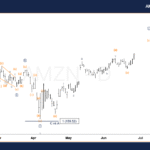
A tentative ceasefire announced by President Donald Trump this evening—but not yet verified by Israel or Iran—may have shifted the course of world markets that were staring down a potential oil shock and elevated inflation just hours ago.
Iran’s parliament voted on Sunday to close the Strait of Hormuz, a vital waterway to the global oil trade. The surprise vote, and ensuing ceasefire, puts in sharp relief the global importance of the narrow strait between Iran and the Arabian Peninsula, which carries 20% of global oil production.
The move, first reported by Iran’s state-run Press TV, comes after the U.S. struck Iranian nuclear sites on Sunday and before Iran retaliated by attacking the U.S. military base in Qatar on Monday. While oil markets slipped 4%, or $3 per barrel Monday, analysts anticipated a sharp price increase if the country’s Supreme National Security Council approved the closure of the strait.
Iran’s supposed plans to shut the strait, while unlikely to actually happen even before the ceasefire announcement, could have resounding effects on European and UK markets—and even a slight disruption on the waterway could shock a U.S. economy already preparing for a rise in inflation. Modest increases in oil prices due to Iranian retaliation in the region could even have effects on how the Federal Reserve navigates rate cuts for the remainder of the year, analysts say.
“[Closing the Strait of Hormuz] could turn into a stagflationary shock like the one we saw in 2022 after Russia’s invasion of Ukraine,” Susana Cruz, research analyst for Panmure Liberum, a UK investment banking firm, told Fortune.
If Iran closes the waterway, Cruz expects the shock in oil prices to increase headline inflation in the U.S. 1%. Another, “more likely,” scenario where the strait doesn’t close but oil prices rise by 20% in the third quarter would increase headline inflation to increase half a percentage point in the U.S., 0.4% in the Eurozone, and 0.3% in the UK, Cruz and her research team predict. This could force the Fed to hold interest rates, a strategy they’ve employed since December despite Trump’s pressure to cut rates.
Iran may not have the ability to back up its threat, even if they move to, experts say.
“[Iran is] making noise about closing the Strait of Hormuz,” Paul Tice, a senior fellow at the National Center for Energy Analytics, told Fortune. “It’s unclear if they have the capacity to do that.”
In line with Tice’s reasoning, Brent crude oil prices edged down from $78.97 at open, hovering around $70 by Monday afternoon, as traders see continued tanker flow on the Strait of Hormuz. Trump implored the oil sector to keep prices low today in a Truth Social post, warning readers: “I’M WATCHING! YOU’RE PLAYING RIGHT INTO THE HANDS OF THE ENEMY. DON’T DO IT!”
But even a transitory 20% increase in oil price could affect the outlook from central banks that brace for “an inflationary impact already building up from the tariffs,” Cruz warned.
“If you have an additional oil shock from oil prices, then we definitely wouldn’t see the Fed cutting rates for the rest of the year,” Cruz said. “[Central banks] need to make sure that this shock is actually transitory and to kind of not make the same mistake that they did in 2022: assuming that it will be a transitory effect on inflation.”
The scenario of a 20% increase in oil prices would peak in the third quarter of this year and disappear in the third quarter of 2026, Cruz said. The U.S. stock market would fall 5% to 10% in this scenario, according to Panmure Liberum estimates.
Despite the U.S. facing “a combination of sticky, high inflation and [a] slow growth economy” Ethan Harris, former chief economist at Bank of America, told Fortune, “I’m much more worried, frankly, about the trade war than I am about the oil price shock.”
Harris holds the view popular among economists that U.S. consumers will start to see the tariff-fueled price increases over the summer, and expects to start seeing inflated CPI reports in the upcoming months.
In his Monday newsletter, Harris wrote that people in the U,S. economy are “more willing” to see oil price shocks as transitory. He added that the U.S. is much less dependent on oil imports than it was during oil price shocks caused by flashpoints like the US-Iraq war in 1990 and is less dependent on oil overall as the country has become more “service oriented.”
“As a result, most empirical work suggests a $10/bbl [per barrel] rise in the price of oil lowers GDP 0.1% or less,” Harris wrote.
Goldman Sachs analysts estimate a “geopolitical risk premium” of $12/bbl, defining the value as the increase in oil price since it closed at $66.9/bbl on June 10. On June 11, Trump said he was less confident about reaching a nuclear deal with Iran.
In a report published Sunday, Goldman analysts said a scenario where the nearly 20 million barrels of oil volumes that flow through the Strait of Hormuz drop 50% for one month and then remain down 10% for another 11 months could cause the Brent price to reach $110/bbl. The risk premium per barrel would rise to just over $25.
Although Harris says there’s “no magic number” to predict an extreme oil shock, the price per barrel would have to reach “well above $100” to threaten a recession.
The Islamic Republic’s oil exports have fallen from around 2.5 million barrels per day to just 150,000 barrels following the outbreak of war with Israel, Israel Hayom reported.
Even if the strait is shut in the future, Macquarie Bank strategists see a workaround.
“Any closing of the Strait would not be completely insurmountable, because some of the oil loaded at Gulf terminals could be shipped overland,” the strategists wrote in a note. “But an associated risk is an Iran attack on regional oil-production sites.”
Twenty percent of global oil production flows through the Strait of Hormuz, and experts say closing the waterway would affect Iran’s economy significantly, as oil is one of the country’s largest exports.
“They would be hurting themselves,” Tice of NCEA said.





